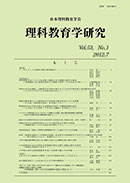
- Issue 3 Pages 1-
- Issue 2 Pages 1-
- Issue 1 Pages 1-
- |<
- <
- 1
- >
- >|
-
Jingze JIN, Tetsuo ISOZAKI2000Volume 41Issue 1 Pages 1-12
Published: July 31, 2000
Released on J-STAGE: June 30, 2022
JOURNAL FREE ACCESSAt the beginning of the 20th century, Japanese science education exerted a considerable influence on Chinese education. This study focuses on Chinese translations of Japanese science textbooks in order to examine the extent of the Japanese influence on the production of science texts in China. The study makes the following points: 1. The translation of Japanese school science textbooks, which were popular with Chinese science teachers, was motivated not only by the recognition and the efforts of Chinese leaders and educators, but also by the urgent necessity to compile textbooks in China. 2. Many Japanese people implicitly influenced the selection of the texts to be translated by recommending the most popular books. Chinese students in Japan and Chinese people who had learned Japanese in order to study natural science took part in the translation of text books. 3. As well as being numerous, Chinese translations of Japanese school science textbooks were evaluated highly for their quality. Due to the distribution of authorized textbooks by the Xuebu (the Chinese Ministry of Education), the Japanese style of compiling and organizing textbooks became popular in China 4. The aims of science teaching in China resembled those in Japan and some unique characteristics of Japanese science textbooks, such as detailed content and syllabus coverage promoted similar qualities in China
View full abstractDownload PDF (1700K) -
Izumi OHTAKA2000Volume 41Issue 1 Pages 13-24
Published: July 31, 2000
Released on J-STAGE: June 30, 2022
JOURNAL FREE ACCESSReproduction of the basic conception of the nature underlying modern science in science education is important for understanding the uniqueness of science education and for the learning of science in Japan. But the theme has never been studied until now. Three viewpoints on the theme are proposed: the history of science education, the aim of science education, and the comprehensive study on the theory and practice of science education, including the comparative study of education. The way of teaching the ''Mathematisierbarkeit" of nature in M. Wagenschein' s exemplarisches Lernen und Lehren and its significance are made clear through an analysis of his process of teaching the law of fall. The results show theory and practice of reproduction of the basic conception of nature underlying modern science in science education in western, where modern science was born.
View full abstractDownload PDF (1592K) -
Yutaka ARAI2000Volume 41Issue 1 Pages 25-36
Published: July 31, 2000
Released on J-STAGE: June 30, 2022
JOURNAL FREE ACCESSIn scientific study, the locomoting viewpoint ability performs an important role. Directional, symmetrical, and rotational concepts, (right and left, forward and backward, and angle and direction) are formed on the basis of the locomoting viewpoint concept. These spatial concepts are essential for students to be able to recognize the spatial extent of astronomical materials and the relative motion of astronomical bodies. In Japan there is no clear placement of this target in the unit lessons. Moreover, it is difficult to say how to develop the locomoting viewpoint ability in science education. It is necessary to create an effective teaching method and materials. Accordingly, in teaching about the earth's rotation in the astronomical lesson unit, the author focused on the development of the locomoting viewpoint ability by designating the necessary spatial concepts as the target of the unit and lesson. And also to achieve this goal, the author developed a group lesson material consisting of a transparent hemisphere that the students could produce in the lesson. So a practical curriculum was prepared with a new teaching target and a group lesson material, and lessons based on this curriculum were used with students in the first year of junior high school (seventh grade). The following results were obtained through lesson evaluation data and actual student activities: (1) The unit target and the lesson target on developing the locomoting viewpoint ability are sound. The group lesson material, which promoted the development of the locomoting viewpoint ability, is effective. The students developed the locomoting viewpoint ability, the mental operation that supports the spatial cognition concept ability. (2) The above-mentioned spatial recognition of directional, symmetrical, and rotational concepts and relative position were developed organically, and students were able to learn the heliocentric theory
View full abstractDownload PDF (1596K)
-
Michio MATSUBARA2000Volume 41Issue 1 Pages 37-46
Published: July 31, 2000
Released on J-STAGE: June 30, 2022
JOURNAL FREE ACCESSThe following two points were thought to be necessary for research on the natural recognition to be useful for science education: clarifying the cause or reason why the characteristics of natural recognition were formed and showing the ideas necessary to arrange each research project. The object of this study was to propose a theory of Connectionism, that is, parallel distributed processing, in order to resolve these points. The following points could be explained by the theory of Connectionism: (1) the mechanism of production of framework such as prototype and theory-ladeness (2) the mechanism of flexibility of schema to conditions (3) the reason why mental models and metaphors were useful for recognition (4) the reason why logical thinking was hard to develop in a short time (5) the reason why naïve concepts were held to and difficult to change (6) the ideas that related research on situated cognition to research on internal activities Furthermore, it could be shown that Connectionism proposed a single idea to arrange each research project through the neural network models.
View full abstractDownload PDF (1128K)
- |<
- <
- 1
- >
- >|